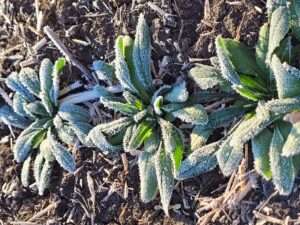
LUARS Thunder Bay is testing winter camelina, Anvol and Holganix!
Dr. Tarlok Singh Sahota CCA
Lakehead University Agricultural Research Station (LUARS, formerly TBARS) Thunder Bay
has always been looking for new opportunities for its area producers and attempted to test new
crops and products. This year we are testing three new things:
1. Winter camelina: Winter camelina is an oil seed crop from the mustard family. I got its seed
from Christina Eynck, Research Scientist, Oilseed Breeding for Biofuels and Bioproducts,
AAFC Saskatoon. As per Eynck, it is a short-season crop, possesses very good frost tolerance in
the seedling stage and the full-grown plants exhibit good drought tolerance. It is resistant to flea
beetles and black leg disease. Pod shattering is not an issue in camelina; therefore, it can be
straight cut. Camelina seeds should be harvested when 80-90% of pods are mature, that is yellow
to grayish-brown in color. Seeds must be dried to 8% to 9% seed moisture to maintain seed
quality.
The average oil content of winter camelina cultivar Joelle is 40-41%.
Winter camelina flowers earlier (late April) than other crops, and even earlier than most spring-
flowering wild plants. Consequently, its flowers are prized by many native pollinators as well as
honey bees. Camelina flowers provide abundant pollen and nectar for them. Late August to mid
September is considered an optimum window for seeding winter camelina in the Prairies. We are
trying to find out its optimum time of seeding and winter survival potential under our agro
climatic conditions by seeding it at 10 days interval from August 25 to September 25.
2. Anvol: Anvol is a urease inhibitor, a nitrogen stabilizer, with double ingredients – NBPT
(Agrotain) and Duromide from Koch Agronomy Services, Calgary. Urease is an enzyme
that catalyzes the hydrolysis of urea, forming ammonia and carbon dioxide. Untreated urea
quickly hydrolyses in moist soils and is subject to losses of N as ammonia through volatilization.
Anvol gets to work faster and provides a longer duration of protection from nitrogen loss through
volatilization. Koch Agronomy Services sells urea treated with Anvol; farmers therefore don’t
have to treat urea with it. We are comparing Anvol treated urea with urea, ESN, urea superU and
their blends in spring and winter wheat.
3. Holganix Bio 800 + : Holganix contains more than 800 species of microbes. It is claimed to
improve plant performance and yield by maximizing soil health and uptake of nutrients, minerals
and water, increasing plant resilience against various stresses, boosting root architecture, faster
crop establishment, improving nutrient use efficiency and lowering fertilizers and herbicides
needs. Some of the soil microbes contained in Holganix Bio 800 + Agriculture include both
Phosphorus and Micronutrient Solubilizing Bacteria, Nitrogen Fixing Bacteria, Plant Growth
Promoting Bacteria, Plant Debris Degrading Bacteria and Fungi,
Mycorrhizae Fungi, Trichoderma Fungi, Penicillium Fungi, Beneficial Nematodes, and Protozoa
(https://www.holganix.com/bio-800-agriculture). We are testing Holganix in winter wheat and
winter rye by its soil and foliar application @ 0.5 US gallon/acre.
